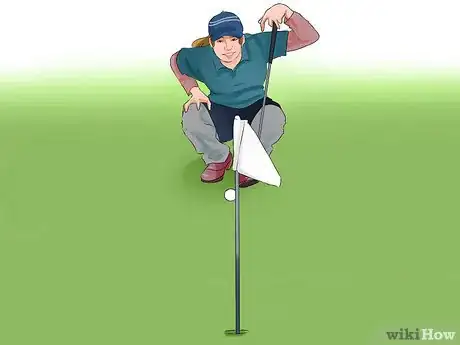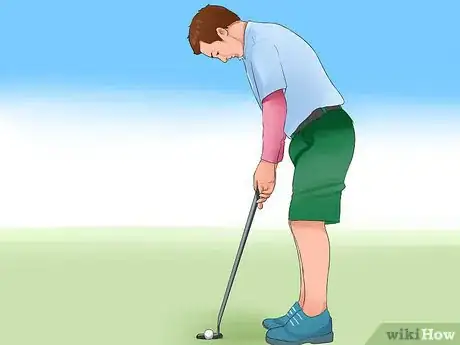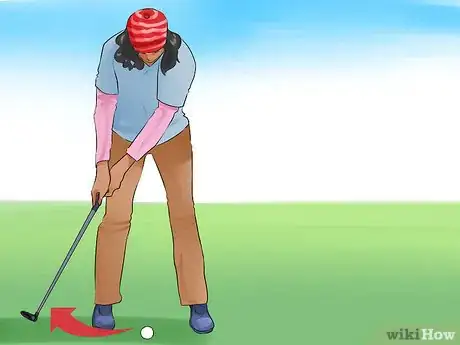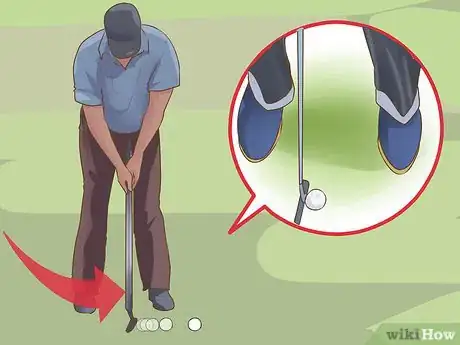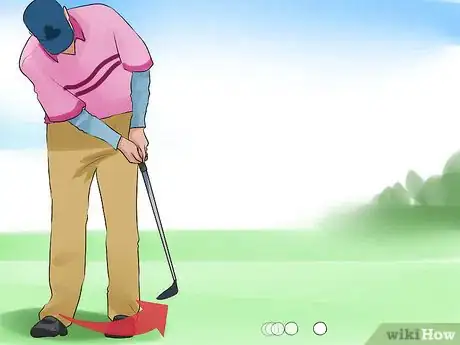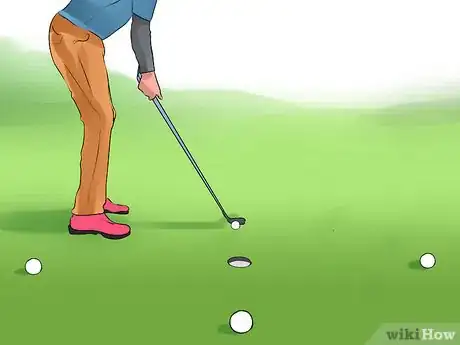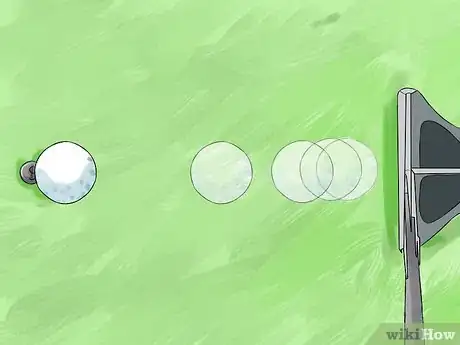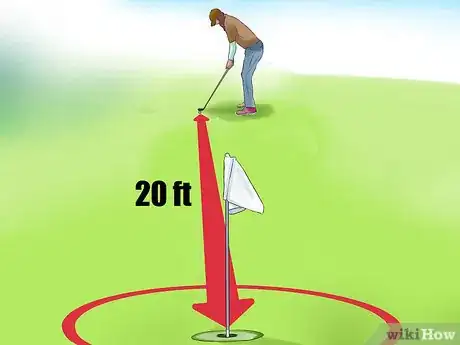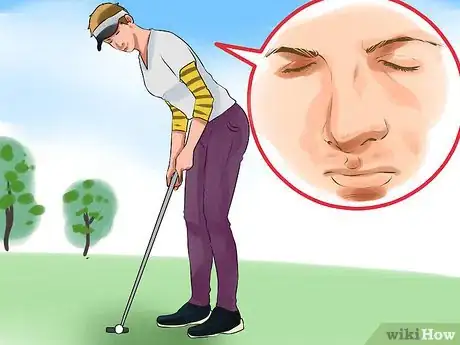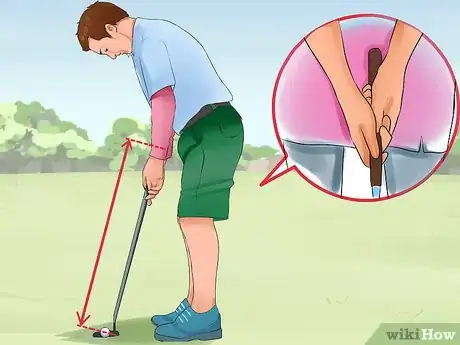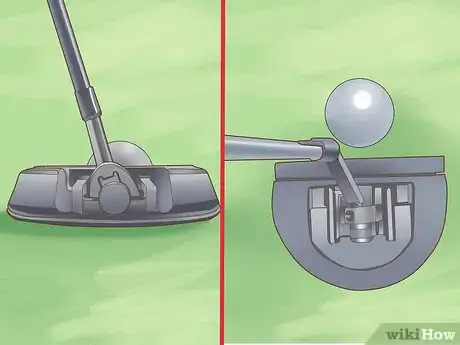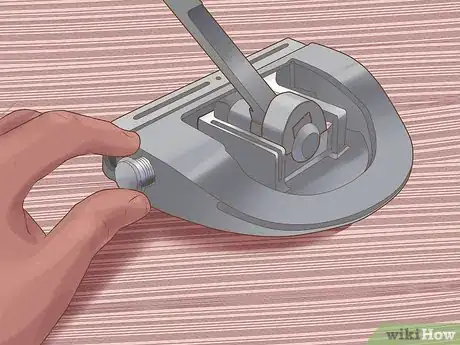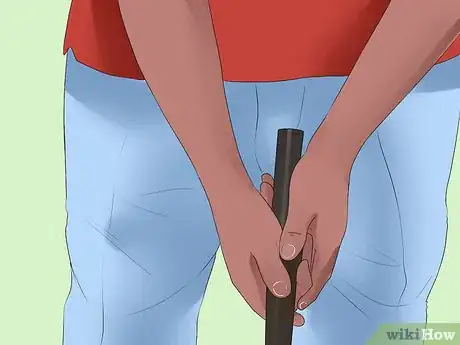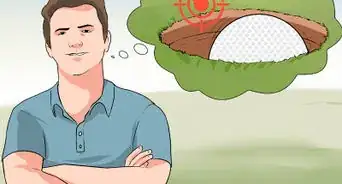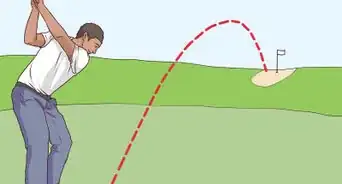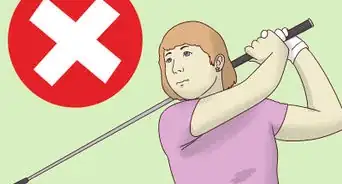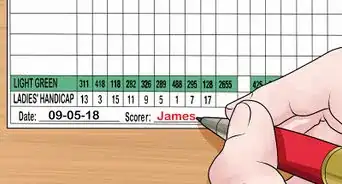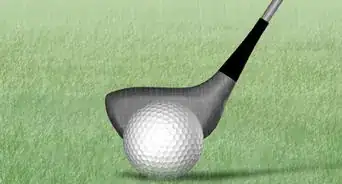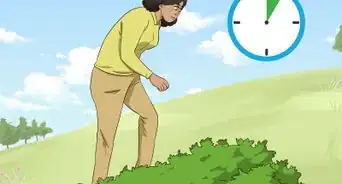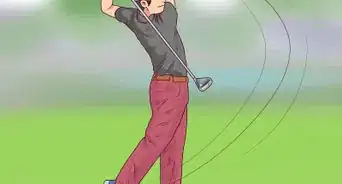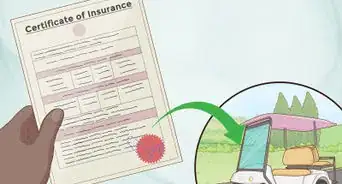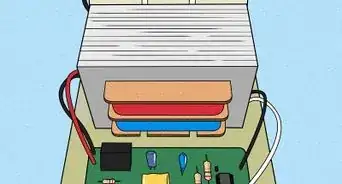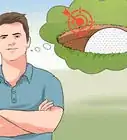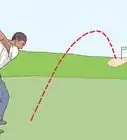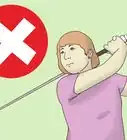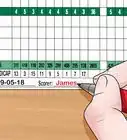X
This article was co-authored by Michael Metz. Michael Metz is a Golf Instructor and the Director of Instruction at Simi Hills Golf Course. With more than 15 years of experience, Michael is adept at coaching all facets of Golf. Mike uses technology, such as Flightscope, V1 Swing Suite, Blast Motion, and BodiTrak pressure mapping, to provide advanced golf training with quick results.
This article has been viewed 43,276 times.
Your whole golf game can be ruined if you can't putt. Missing putts is the fastest way to put a bad number on your scorecard. It is arguably the hardest part in golf, but the skill can be improved.
Steps
Method 1
Method 1 of 3:
Perfecting Your Putting
-
1Look around you before you putt. Unlike full shots that have to do with the air, putting is all about the contour of the ground. Look at all your putts from behind the hole and from a 90-degree angle. This will give you a clear idea of the distance and elevation of the ground before you putt. [1]
-
2Set the ball near your front foot. The ball should be square to the line of target and your eyes should be over the ball. Let your arms hang loosely and hold the putter lightly. Make sure to keep your hands level or ahead of the ball through the stroke. [2]Advertisement
-
3Swing the putter. Move the putter backward smoothly. Use your shoulders to hinge your arms, not your elbows or wrist. Keep your putter in line with the target as your swing it backward and then forward. Maintain your tempo through the swing. [3]
-
4Strike the ball with slight speed. The putter head should strike the back of the ball during the upswing. It should feel like the palm of your right hand is striking towards the target. The best strokes look very smooth because the club is being swung backward and forward at the same speed. [4]
- The strike should feel more like a “roll” rather than a “hit.” This will give you better distance control and keep the ball from rolling too far past the hole. [5]
-
5Follow through with your club. Don't follow through with your eyes. Keep eye contact on the spot where the ball was, not where it is going. Don't allow yourself to look up right away, count for two second before you look to see how well you did. [6]
- Many golfers make the mistake of having a short follow through and not paying attention to the force of their follow through. Make a long follow through to the hole, it should not be shorter than the takeaway.
Advertisement
Method 2
Method 2 of 3:
Using Drills
-
1Do the “Around the World Drill” or “Clock Drill.” This is an exercise where you will have to be consistent and focused. Find space on the putting green around a hole.
- Set up four golf balls around the hole. The balls should be equal distance from the hole. Your goal is to get them all into the hole.
- Each time you make them all into the hole, move them a foot further from the hole. If you mess up, you have to start all over.
-
2Do the “Coin Drill,” to improve accuracy. Set up a coin about a foot in front of the ball and putt over the coin. Try to get the ball to go right over the coin. You can use a flat stick to guide your path to the coin if you need to. This drill will help improve your accuracy when putting.
-
3Practice your long putts with the “Long Putt Points Drill.” The putts that are 20 feet (6.1 m) and further are difficult for many golfers. The goal of this drill is to put the ball in a three-foot range of the hole to be able to make a two putt. If you make a two putt, then give yourself three points. If you make it within the three-foot circle give yourself one point. This way you will be able to track your progress.
-
4Close your eyes in the “Mind's Eye Drill.” When you are about to putt and have everything where you want it to be, close your eyes. This will help you relieve your mind and not worry about the ball or the hole or your putt. Putting with your eyes closed works best for short putts. [7]
Advertisement
Method 3
Method 3 of 3:
Fitting Your Putter
-
1Make sure your putter is the correct length. It is important that your putter is the appropriate length for you so you can have your hands in the optimal spot on the putter. Place your hands on the meat of the putter grip then adjust the height of the putter to match. Length of the putter is important for a sound setup and for your hand-eye coordination. [8]
-
2Optimize your angles to keep the ball stable. The loft, the angle of the club face, lifts the ball from the depression it makes on the green and gives the ball a backspin. Adjust the loft of your club so it comes at the ball straight on. [9]
- The lie angle, the angle between the center shaft and the ground, can negatively affect a golfer's set up and stroke. Keep the lie angle where your natural set up is so you don't mess up your stroke. [10]
-
3Find the club weight that is perfect for you. If the club is too light it will make it swerve during the follow through. Add more weight to your club if you notice a jerky motion and difficulty controlling the club. Use a lighter head weight for faster greens and heavier weights for slower greens. If you tend to miss putts in a certain side of the putter, add weight to that side.
-
4Keep your grip large when putting. Although there are many different ways to grip the club, when putting, keep your grip large. This will keep your wrists from breaking and the putter from being manipulated. Having a large grip will keep the swing in your shoulders, giving you more control. [11]
- You want to go to the side of the hand so you want to feel like you're going to take your hands on either side of the putter handle.
- Make sure your thumbs are aligned and with a neutral grip. You don't want a strong or weak grip, because the putter may open or close to impact.
Advertisement
Expert Q&A
-
QuestionHow do you know how long your putter should be?
 Michael MetzMichael Metz is a Golf Instructor and the Director of Instruction at Simi Hills Golf Course. With more than 15 years of experience, Michael is adept at coaching all facets of Golf. Mike uses technology, such as Flightscope, V1 Swing Suite, Blast Motion, and BodiTrak pressure mapping, to provide advanced golf training with quick results.
Michael MetzMichael Metz is a Golf Instructor and the Director of Instruction at Simi Hills Golf Course. With more than 15 years of experience, Michael is adept at coaching all facets of Golf. Mike uses technology, such as Flightscope, V1 Swing Suite, Blast Motion, and BodiTrak pressure mapping, to provide advanced golf training with quick results.
Golf Instructor For an accurate length, you must get fit by a professional. Everybody stands a certain way. What I'll typically look at is somebody's waist height, their inseam, and then how low their hands are. A professional will incorporate all of those components into a putter recommendation specific to your body type.
For an accurate length, you must get fit by a professional. Everybody stands a certain way. What I'll typically look at is somebody's waist height, their inseam, and then how low their hands are. A professional will incorporate all of those components into a putter recommendation specific to your body type.
Advertisement
References
- ↑ http://www.golftipsmag.com/instruction/putting/keep-it-simple/
- ↑ http://news.bbc.co.uk/sport2/hi/golf/skills/4238292.stm
- ↑ http://news.bbc.co.uk/sport2/hi/golf/skills/4238292.stm
- ↑ http://news.bbc.co.uk/sport2/hi/golf/skills/4238292.stm
- ↑ http://compugolfcenter.com/putting-rolling-versus-hitting
- ↑ http://news.bbc.co.uk/sport2/hi/golf/skills/4238292.stm
- ↑ http://www.golftipsmag.com/instruction/putting/keep-it-simple/
- ↑ http://www.golftipsmag.com/instruction/putting/get-fitted/
- ↑ http://www.golftipsmag.com/instruction/putting/get-fitted/
About This Article
Advertisement
